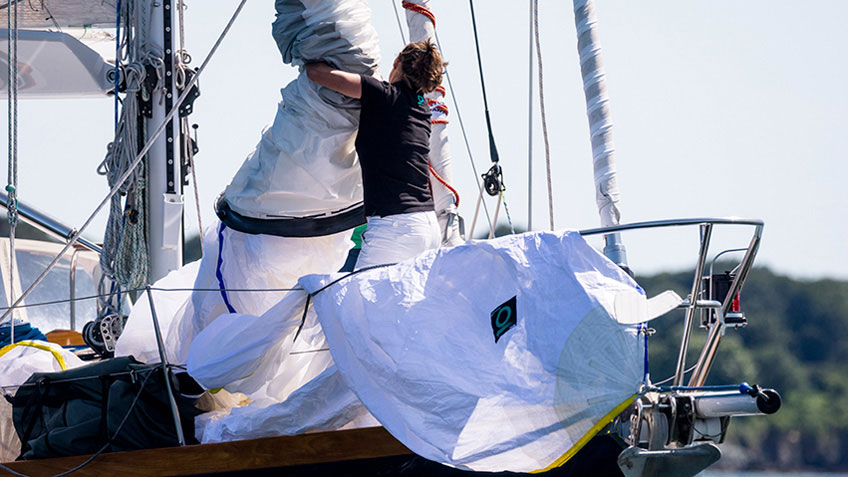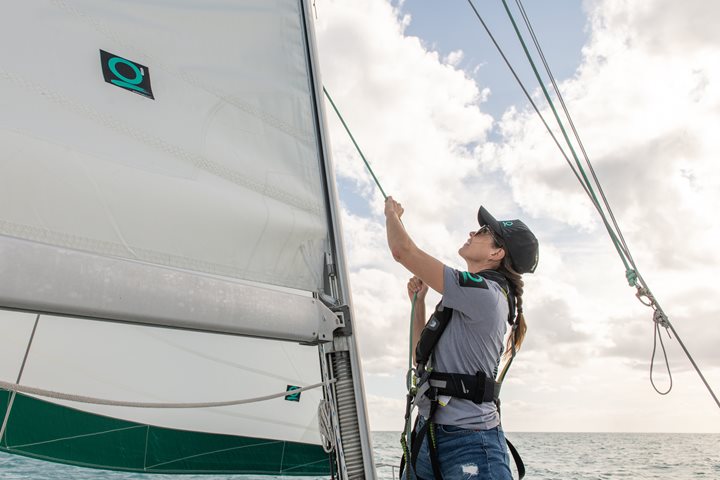There isn’t a one-size-fits-all sail inventory for cruisers. From sail materials to downwind sails and code 0s, it’s important to understand the options in order to build the perfect cruising inventory for your needs.

Offshore cruiser to day cruiser—no two sailors’ needs are alike. That is why it’s important you understand your options so that you and your sailmaker can develop the perfect cruising inventory to meet your unique needs. Read on to learn about your options, and click the links for a deeper dive.
Sail Material
Before considering your sail options, it’s important to understand a bit about choices in sail materials. There are essentially two options: conventional woven sails and composite sails. Beyond price, the main difference between the two comes down to performance and longevity.
To most cruisers, performance is less about boat speed and more about control over heel and weather helm. Poor sail shape is the main culprit responsible for performance issues; therefore, the key to building the best cruising sail lies in reducing stretch. This is where the value of composite sails, or membrane sails, comes in. Composite sails use big, straight unwoven fibers to bear the load instead of small woven fibers. Since composite sails are unwoven, there is no “crimp” as they don’t weave over and under the fiber running in the opposite direction. The result is a sail that can resist stretch as much as 500 percent more than a traditional woven sail.
Spend some time exploring the right sail material for you, your needs, and your budget.
LEARN MORE
The Mainsail
When it comes to the mainsail, battens are a key factor. Battens are like the framework of a tent: they provide the much needed structure and support that help maintain your sail’s shape and durability. By keeping the material taut and smooth, battens preserve the open-leeched airfoil shape and prevent the sails from becoming too full when breeze increases.

Most sail handling systems accommodate some type of batten configuration. Your sail handling system and the size of your boat will dictate the batten size, type, and material. In-mast furling systems are the exception, however, because vertical oriented furling can’t have horizontal battens. In-mast furling systems are some of the easiest and most reliable systems, so, depending on your needs, it might be worth making compromises on size and shape. Vertical battens can be an option, but they come with their own set of constraints. If the never-leave-the-cockpit ease of an in-mast furling system is appealing but you don’t want to sacrifice performance, consider an in-boom system with horizontal battens, though an in-boom system requires a bit more attention, especially when lowering.
LEARN MORE
The Headsail
Most sail inventories should have a minimum of two headsails: a genoa and a working jib. However, the type of sailing you do and specific needs will dictate the number of headsails. Offshore cruisers, for example, need a wider range of headsails to sail safely, while day cruisers can get away with a slimmer inventory.
Working jibs are pretty straightforward as they tend to have an LP (the shortest distance from the clew to the luff) between 85-100 percent of the distance from the headstay to the mast. These are heavy-duty sails designed for 15-18 knots and above. Working jibs are used more often than anticipated and are a great sail to have in your quiver.
When it comes to genoas, there is a wide range of options. As a general rule, handling and versatility should be the key deciders; thus, you want to choose the smallest sail that will point reasonably well in light to moderate conditions. You also need to consider the normal conditions where you live, if you want to be able to partial furl, and functional aspects like clew height. The size of your headsail will play a large role in what sail handling system you choose. Roller furlers have become the most common due to their reliability and ease of use.
LEARN MORE
The Cruising Spinnaker
A spinnaker is larger and has more shape than a working sail, making it better at broad angles. Today’s industry standard for cruising spinnakers is the asymmetrical spinnaker. It is designed to set the tack to a fixed point on the bow, with a distinct luff and leech. With no pole, asymmetrical spinnakers are a lot easier to operate.
Choosing the right spinnaker comes down to the apparent wind angle you want to optimize for. Most cruising sailors are looking for one spinnaker to do it all, making an all-purpose reaching sail (a mid-range A3) for apparent wind angles of 80-140 degrees the best choice. If you’re looking to optimize for broad reaches of 110-155 degrees, you’ll need to choose an all-purpose running sail (A2) and also consider a bowsprit. Assuming you won’t use the sail in heavy wind, lighter material will perform the best and keep down the weight on the boat.
Your handling system will also play a role in the type and size of kite you choose, especially if you have a preference. Top-down furlers are great for smaller kites, but they become more difficult as girth increases. Spinnaker socks are a great option for any size kite.
LEARN MORE
Reaching Sails: The Code Zero
This sail tends to be one of the most used and versatile in a cruiser’s inventory. A Code Zero reaching sail is perfect for light air on close angles upwind, broad angles in heavier breeze, and all the angles in-between. Because the Code Zero's mid-girth is anywhere from 55-75 percent, which allows it to be very deep and flat, a Code Zero has the ability to take you through more wind angles than any other sail on the boat.
Code Zero sails are deployed from a furler, making them easy to handle. Depending on your boat, Code Zero sails are made from either a thin plastic-like material or nylon. They also come with a UV cover so the sails can stay hoisted on the furler for days during a long trip. They can sail wider angles, have better shape and are overall easier to handle.
Sometimes referred to as "code zeros" or "code sails," the category of reaching sails gets confusing quickly as the term can apply to a broad range of sails. To simplify and clear up any confusion, Quantum developed our line of reaching sails around the target Apparent Wind Angles (AWA). After all, this is how we actually sail! Check out the options here.
LEARN MORE
While it’s important to have a handle on different sail options, don’t forget your local loft and rep are there to guide you through the process, offering specific ideas to optimize your sail inventory and help you get the most out of sailing.